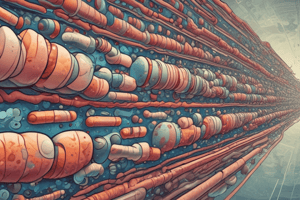Podcast
Questions and Answers
Which of the following correctly describes the action of aminoglycosides?
Which of the following correctly describes the action of aminoglycosides?
- They inhibit bacterial cell wall synthesis.
- They inhibit bacterial protein synthesis. (correct)
- They disrupt bacterial DNA replication.
- They enhance host immune response.
What types of infections are aminoglycosides primarily used to treat?
What types of infections are aminoglycosides primarily used to treat?
- Gram-positive infections only.
- Skin infections and mild respiratory infections.
- Viral infections and fungal infections.
- Urinary tract infections and meningitis. (correct)
Which of the following organisms is NOT typically treated with aminoglycosides?
Which of the following organisms is NOT typically treated with aminoglycosides?
- Escherichia coli
- Salmonella species
- Pseudomonas aeruginosa
- Staphylococcus aureus (correct)
What is the primary mechanism through which aminoglycosides exert their antibacterial effects?
What is the primary mechanism through which aminoglycosides exert their antibacterial effects?
Which of the following drug classes is considered a standard treatment for nosocomial Gram-negative infections?
Which of the following drug classes is considered a standard treatment for nosocomial Gram-negative infections?
Which of these aminoglycosides is NOT used in the treatment of bacterial infections?
Which of these aminoglycosides is NOT used in the treatment of bacterial infections?
Flashcards
Antimicrobial Agents
Antimicrobial Agents
Chemicals used to kill harmful microorganisms in humans.
Antibacterial Agents
Antibacterial Agents
Antimicrobial agents specifically targeting bacteria.
Aminoglycosides
Aminoglycosides
A class of antibiotics that stop bacteria from making proteins they need to survive.
Uses of Aminoglycosides
Uses of Aminoglycosides
Signup and view all the flashcards
Aminoglycosides for Nosocomial Infections
Aminoglycosides for Nosocomial Infections
Signup and view all the flashcards
Aminoglycoside Agents
Aminoglycoside Agents
Signup and view all the flashcards
Study Notes
Antimicrobial Agents
- Antimicrobial agents are substances that eliminate disease-causing microorganisms in humans.
- They can be synthetic, like sulfonamides, or derived from living organisms, like penicillins.
Antibacterial Agents
- Antibacterial agents target bacteria specifically.
- Different classes of antibacterial agents exist for treating bacterial infections.
Aminoglycosides
- Aminoglycosides work by inhibiting bacterial protein synthesis, killing bacteria.
- Used to treat Gram-negative bacterial infections.
- These infections can include urinary tract infections, meningitis, wound infections, and life-threatening sepsis.
- Aminoglycosides are a standard treatment for hospital-acquired (nosocomial) infections caused by specific Gram-negative bacteria like Acinetobacter, Citrobacter, Enterobacter, Escherichia coli, Kleibsiella, Providencia, Pseudomonas, Salmonella, and Shigella.
- Specific aminoglycoside agents include amikacin, gentamicin, kanamycin, neomycin, netilmicin, streptomycin, and tobramycin.
Studying That Suits You
Use AI to generate personalized quizzes and flashcards to suit your learning preferences.




